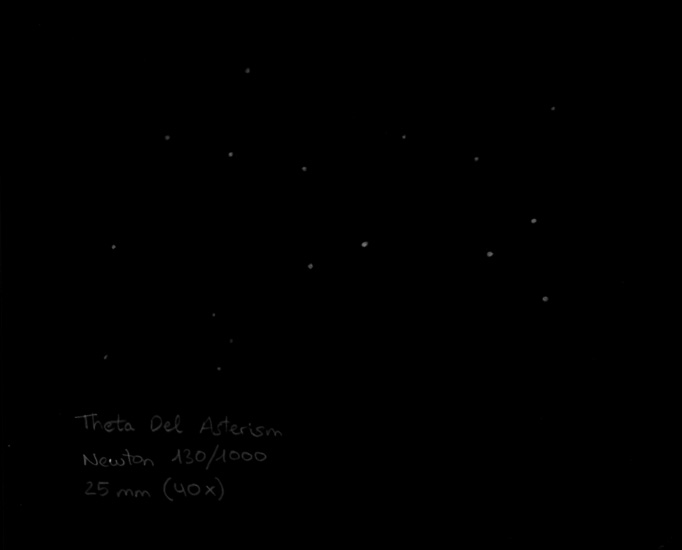
Theta Del asterism by Ursu28
Asterism
Murcia, Spain
August 15, 2013
Graphite pencil
Newton 130/1000
25mm (40x)
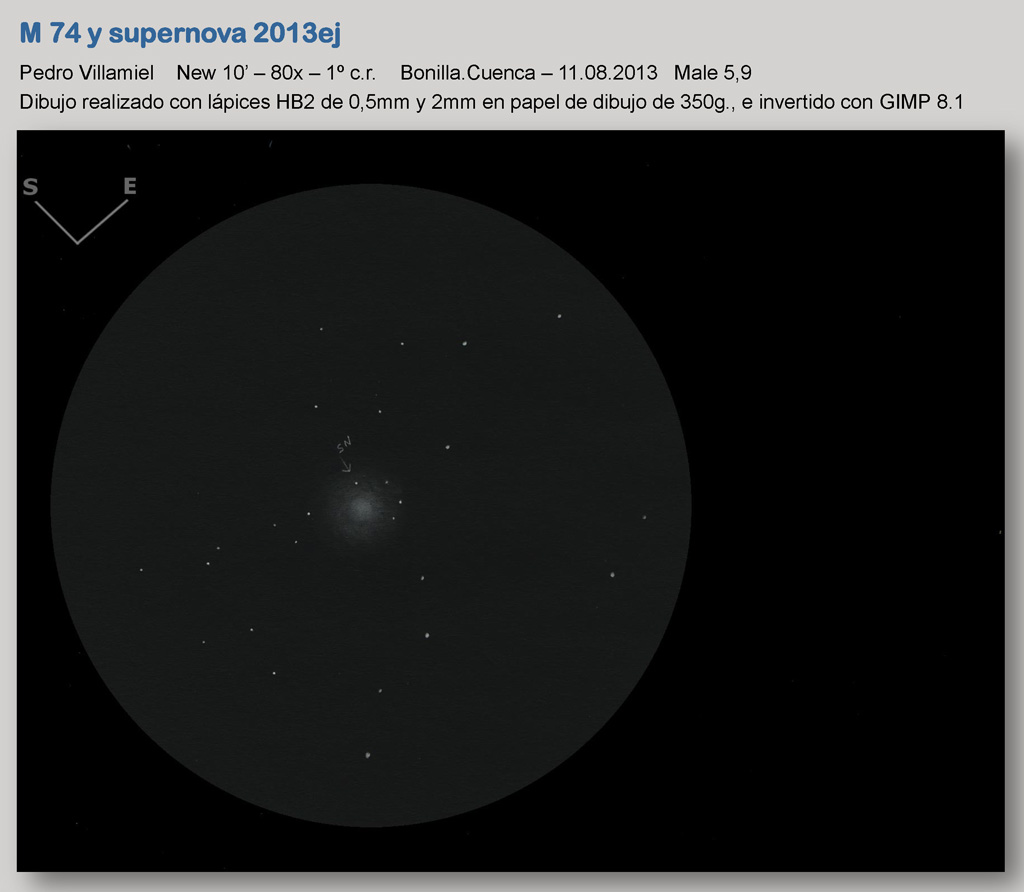
• Object Name: M 74 and NS 2013ej
• Object Type: Face-on spiral galaxy with a supernova
• Location: Bonilla-Cuenca Spain
• Date: August, 11th, 2013
• Media: Graphite Pencil HB 2, torchon 1 and 130g drawing sheet
• inverted colors with GIMP 2.8
Observation notes:
The supernova is shown as a little star in the middle of the southern disk of the galaxy. Of the five stars, I meet in front of M 74, the supernova is closest to its center.
Its brightness is very similar to the nearest star to the west and also to the middle star of the three that are on the eastern edge of the disc (picture below).
Greetings to all visitors of this page.
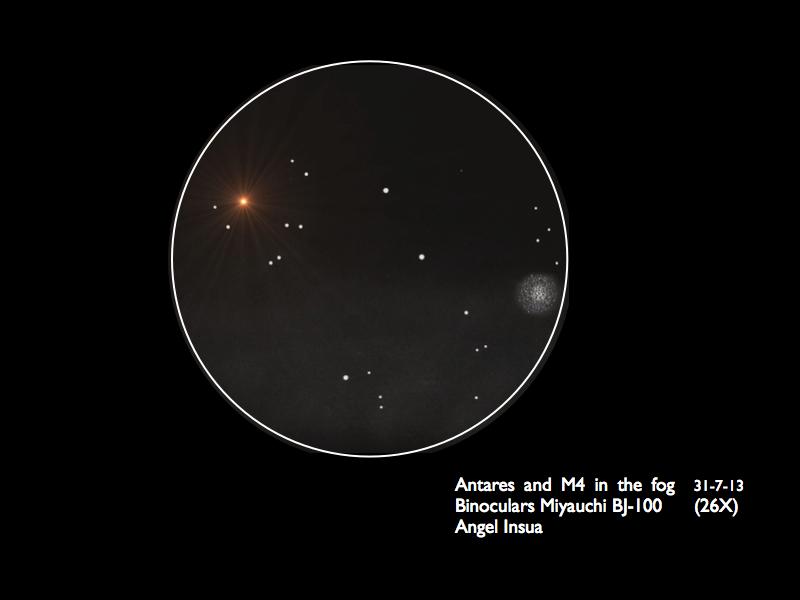
Here, I send you one of my first astronomical drawings; Ive started only a few months ago and I think it’s a new way to enjoy the wonders of the sky.
Best regards
______________________________
ASOD: ” Antares and M4 in the fog”
Object Name: Antares and M4
Object Type: Star field and globular cluster
Date: 31/07/2012
Location: A Coruña, Galicia. Spain.
Media: pencil, white paper, color invert and enhance with Gimp.
Miyauchi binoculars Bj-100 (26x)
Seein: 2/5 (good)
At this time of year, Antares and Scorpio are low on the southern horizon. This is a drawing done before the beautiful red star disappeared into the fog.
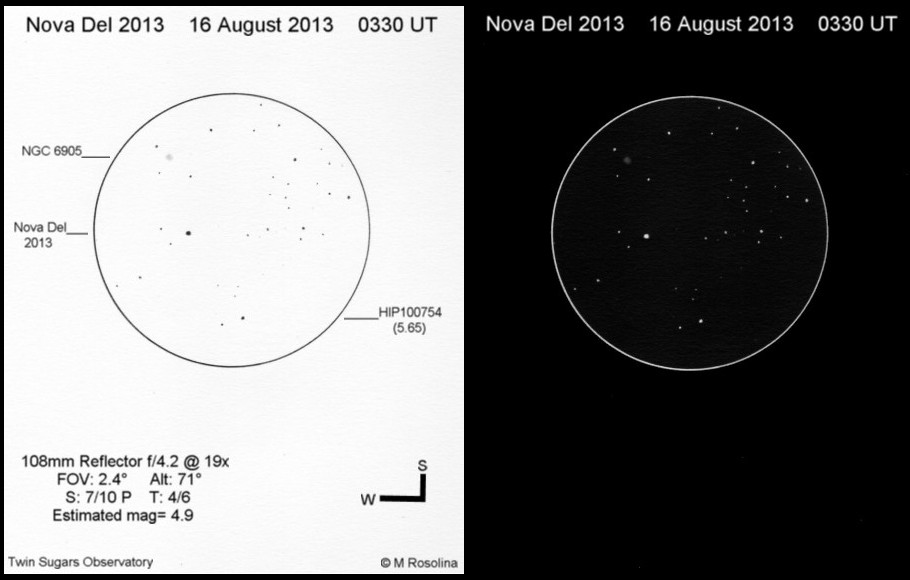
Hello,
Amateur and professional astronomers around the world were galvanized by the recent news of the discovery by Koichi Itagaki of a nova in the constellation Delphinus. The star (actually a binary system) went from about 17th magnitude to a magnitude of 4.5 over a three day period, putting it in the ranks of the 30 brightest known novae.
I had to wait patiently for the clouds to thin enough for me to get this view of the “new star” with my 108mm reflector. A small planetary nebula, NGC 6905 (also known as the Blue Flash) was in the field of view winking in and out as the clouds thinned and thickened.
This observation was made as the nova was still increasing in brightness. By comparing the nova to two nearby stars, eta Sge (mag 5.0) and 29 Vul (mag 4.8), I was able to estimate its magnitude at about 4.9.
A nova occurs when a white dwarf draws enough fuel from its companion star to start an explosive runaway hydrogen-fusion reaction. The resulting cataclysm can be 50,000 times brighter than our Sun (or more)..
I made this drawing at the eyepiece on Canson Pure White drawing paper with 2B and HB pencils and a loaded blending stump.
Name: Nova Del 2013
Type: Nova
Location: Friars Hill, WV USA
Date: 16 August 2013
Clear skies!
Michael Rosolina
Twin Sugars Observatory

Hello all sketchers,
here is my sketch of very nice planet actual on the evening sky – Venus.
Last Saturday was very inspirating for me, so I decided to observe Venus in the evening. Seeing was not very good – 5/10 and it was windy. But i saw some atmospheric detail on Venus how you can see. It was very dificult but I made it!
I used my 8″ dobson with magnifications 150x and 200x and Celestron planetary filter – #15 (yellow).
At first I used OIII Astronomik filter but Venus was not so bright and filter killed all details …
Let’s check the sketch and write your opinion =))
Tom Perdoch
Hlucin (Czech republic)
3.8.2013
20.20-20.30 CEST
Dobsonian 200/1200mm
8mm Hyperion (150x), 6mm Omegon LE (200x)
Celestron #15
Seeing: 5/10. Windy.
Clear sky guys =))
http://www.deepsky-sketches.estranky.cz/
http://www.astrodo.estranky.cz/
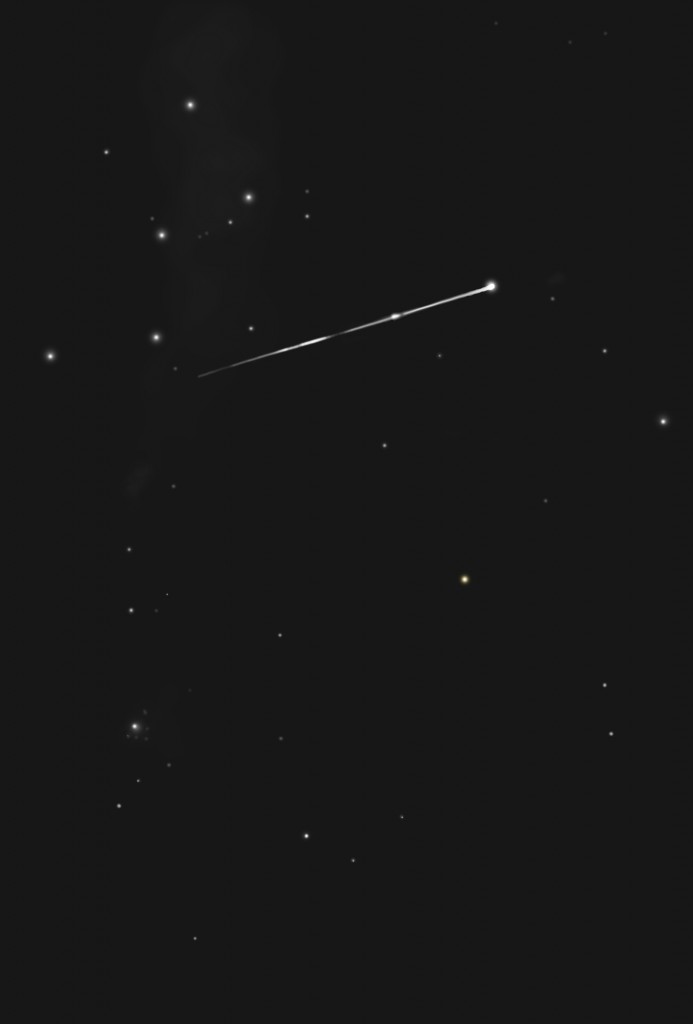
Object Name: Meteor
Object Type: Perseid
Location: Sketched at a dark sky sight in Bristol, UK
Date: 13th August 2013; 00:40am; conditions – very good
Media (graphite pencil sketch and then digitized using graphics tablet and Photoshop)
I usually sketch in some detail (mainly HB and 2B). I then scanned the result into Photoshop and sharpened the sketch.
Observing Details
Had intended to spend an evening under dark skies watching the Perseids. Started out at 11:30pm but after numerous bright meteors over the next hour or so I decided it might be worth trying to accurately sketch one. This meteor came out of Cassiopeia and headed towards Andromeda Galaxy and broke in two as it trailed away. Frustratingly while I was sketching the background stars (and looking down) my pad was illuminated by a flash and on glancing up I realised I had missed a monster heading towards Pegasus – I could see the smoking trail for a good 2 secs. Suffering for my art? Perhaps!!
Hope you enjoy,
Clear Skies
Chris Lee
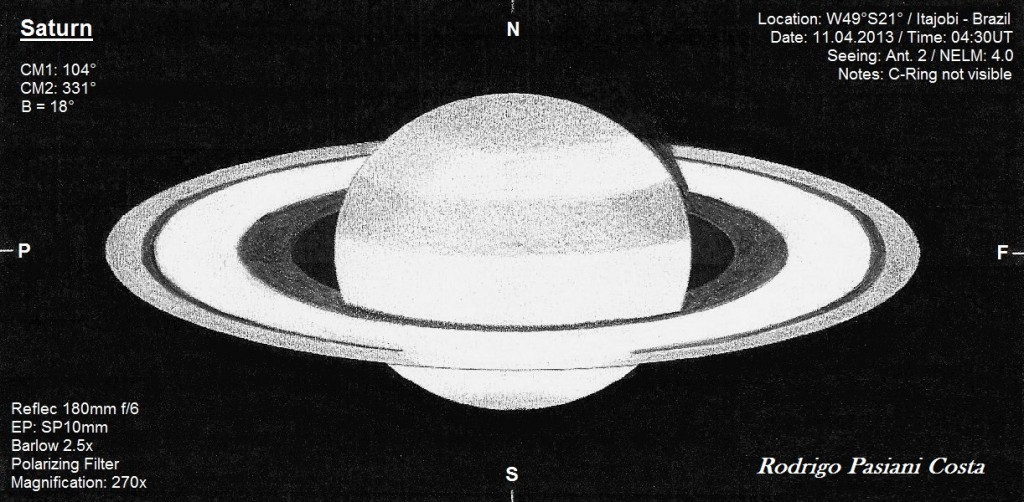
Saturn
Apparent Magnitude: 0.2
Az./Alt: 180°/81°
Itajobi, Brazil
S21°19′ / W49°03′
April 11th, 2013
04h30 (U.T.)
180mm dobsonian reflecting telescope f6 dob mounted (ATM Sebastião Santiago Filho)
Antares 10mm Super Plossl eyepiece
Orion Single Polarizing Filter
GSO 2.5x Three-Element Barlow Lens
Magnification: 270 x
Seeing: Antoniadi II (good, 2/5)
NELM: 4.0
Media: Faber Castell 6B pencil on white paper (BAA form)
Hi, my dear friends. One year later I am back with a Saturn sketch.
I made this sketch in April this year, but only now I found some time to scan and submit it. I hope you astronomers and enthusiasts enjoy.
No clouds, no Moon and no wind. The night would be perfect, wasn’t by the seeing (Ant. 2) and the city lights (NELM 4.0). I decided to observe from my backyard instead of moving all the equipment to the farm.
Despite the limitations, the favorable position of the giant planet revealed several typical features, like Cassini Division, rings’ and globe’s shadows on each other and five of its numerous moons. C-Ring was not visible.
The five visible moons were Japetus, Rhea, Tethys, Dione and Titan.
Clear sky to everyone!
Greetings from Brazil,
Rodrigo P. C.
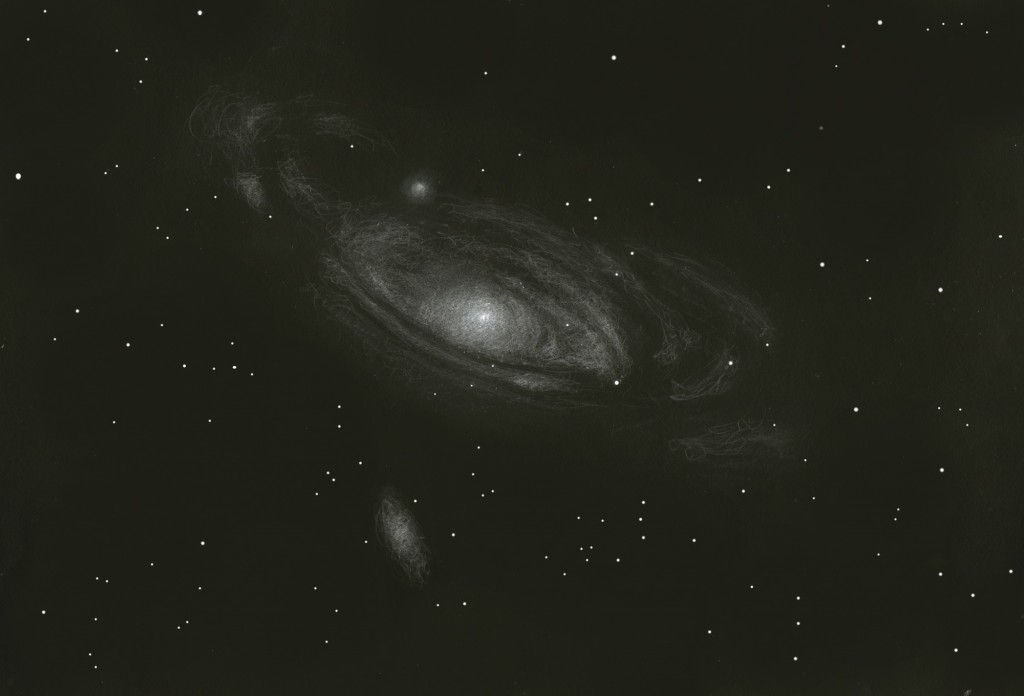
M31, spiral galaxy
M32 and M110 dwarf eliptical galaxies
Nicolas ZANNIN
Dobson Orion Optics 300/1200mm
Eyepiece : principally Uwan 28mm, and Nagler 16mm for check some spiral details near the core.
Good summer sky, but not perfect. altitude : 800 m
Forêt de la Joux, near Champagnole, Jura, France, 01/08/2013
Pencils on white paper
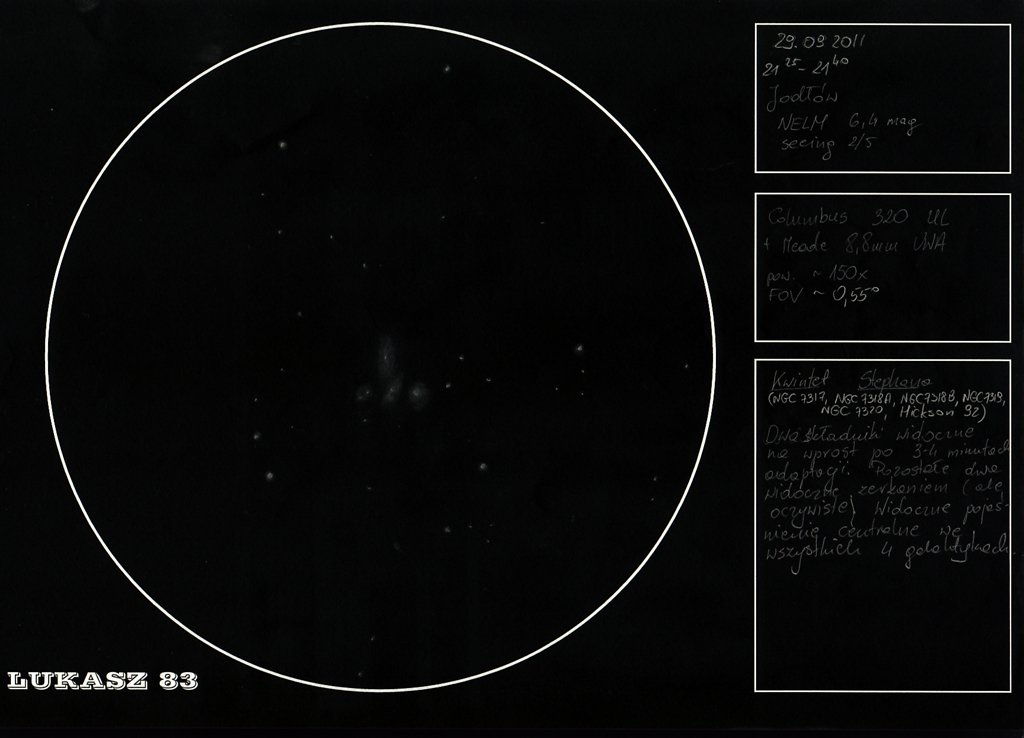
Object Name: Stephan’s Quintet (NGC7317, NGC7318A, NGC7318B, NGC7319, NGC7320)
Object Type: galaxies in Pegasus
Location: Jodłów – small village in southern Poland (picture made during StarParty Jodłów 2011)
Date: 29.09.2011
Media: graphite pencil, white paper, color invert
Telescope: Columbus 320UL (320/1384 Newtonian) + Meade 5000UWA 8,8mm
Seeing: 2/5 (good)
Transparency: 2/5 (good)
NELM: 6,4 mag
One of the most popular “challenge objects”. If you want to observe this objects, one thing is very necessary – clear dark sky. Why? This objects are vey faint so good contrast between galaxies and sky is the most important thing. After few minutes of eye adaptation you can observe four very faint galaxies on the longest side of triangle of three bright stars (it is quite easy to find because it is near very bright galaxy NGC 7331). Very interesting objects – you must have it on your observation list under really dark sky.
Clear Sky
Łukasz